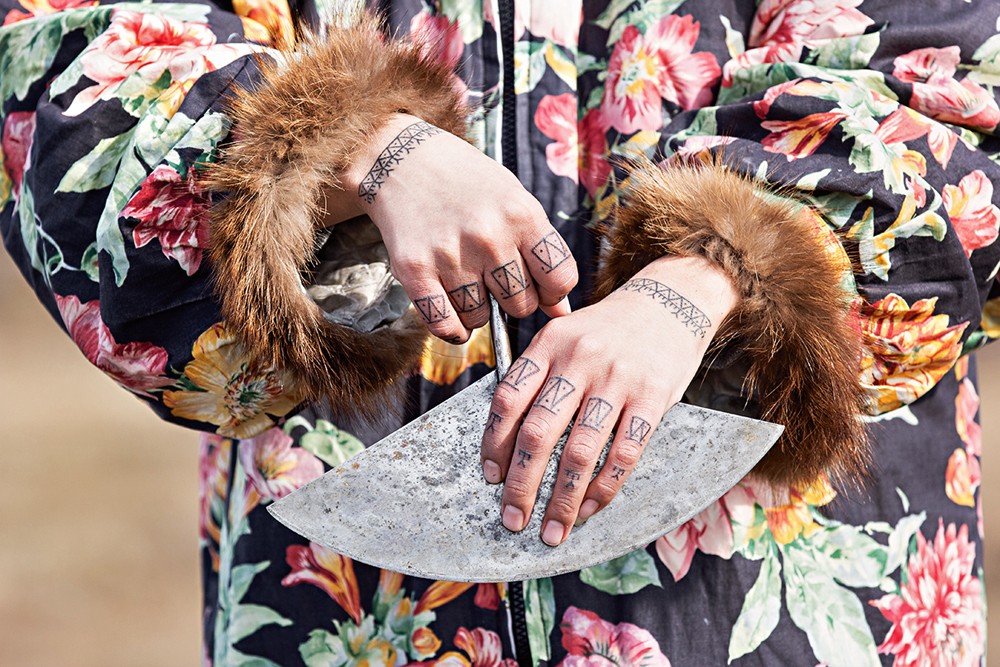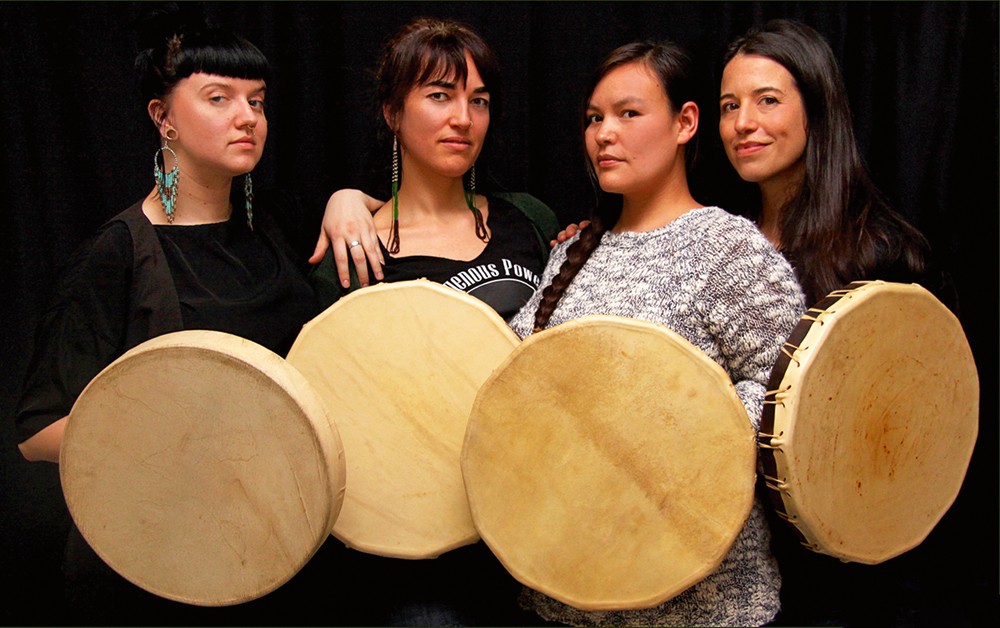Contemporary Native Art Biennial/ La Biennale d’Art Contemporain Autochtone 2018
The fourth edition of the Contemporary Native Art Biennial/La Biennale d’Art Contemporain Autochtone 2018 (BACA) spanned four main locations: Art Mûr, Stewart Hall Art Gallery, La Guilde and Sherbrooke Museum of Fine Arts, with further programming at the McCord Museum. The four exhibitions were replete with a rich program of performances, screenings and roundtables.
The exhibition, co-curated by Niki Little and Becca Taylor, “níchiwamiskwém | nimidet | ma sœur | my sister” honoured Indigenous women’s relationships with one another and brought female voices into the gallery spaces. As curator Taylor stated, “We felt very strongly that we could activate women’s voices,” and that through this exhibition and with the affiliated galleries and the Aboriginal Curatorial Collective/Collectif des commissaires autochtones (ACC-CCA), this would build capacity for Indigenous artists. The intent wasn’t only presenting women’s work, but also to reveal the perspectives of an Indigenous sisterhood and reach women, feminine, transgendered, non-binary and two-spirited in an attempt to create space that at the same time moved outside the marginalized view of Indigenous women. The 40 artists were brought together as a shared collective with diverse art practices, including performance, installation, dance, sound and video art and political agitation as well as wide-ranging art media: photography, textiles, tattooing, collage, beading, painting, sculpture, basketry, printmaking and drawing. The works were chosen to convey elements of Indigenous social, political, ceremonial and physical territories, since these also expand connections of kinship with and for sisters and sisterhood.

Community tattoo action with Hovak Johnston, Inuit Tattoo Revitalization Project, Mary Taletok de / from Kugluktuk. Photo: Little Inuit Photography. Courtesy La Biennale d’art contemporain autochtone.
Selected through a national call for proposals as a part of the ACC-CCA Tiohtià:ke Project (https://www.acc-cca.com/tiohtiake), curators Little (Oji-Cree-English) and Taylor (Cree-Scottish-Irish) situated the collective exhibition “níchiwamiskwém | nimidet | ma sœur | my sister” on their own experiences of sisters and women-gendered relationships. The theme gave the curators a chance to think about all types of relationships and led them to consider things such as feminine space and what the definition of that space entails. They determined that the gallery spaces and their surroundings would define each venue, although the commonality was always traces of the land and water. The land and the water were especially potent at the Stewart Hall Gallery, situated on the shore of the St Lawrence River. There, the work of KC Adams’s (Cree) nibi (water), 2016, referenced the water and small vessels of river water were carried into the gallery. Euroma Awashish’s (Atikamewk) Kakakewok, 2018, allowed traces of water and land to come through in an installation of a circle of crows, connected in some way to a bowl of water. Each of the other works in this exhibition signified both transformation and communication between each of us and our ancestors. This was also evident in Carla Hemlock’s textile work, Faces That Are Yet to Come-Tehatikonhsatatie, 2011, which speaks across generations backwards and forward toward those to come. Catherine Blackburn’s (Dene) Us, 2017, as well, is a close-up image of a syllabics beaded tongue, a work related to her series “Our Mother(s) Tongue,” investigating identity, place and language and also speaking to issues of resilience, survival and collective memory through gathered images of family members.
Art Mûr was the largest venue, where works by 25 artists were presented with selections from La Guilde’s historical basket collection. The inclusion of these baskets, anonymous, regional and often undated, spoke to and acknowledged women’s work from the past, but at the same time asserted their presence in the gallery. These small works set the tone for the space, envisioned by the curators as one where women interacted and made work together. Implicit in the theme at Art Mûr was an activated site of gathering where the works invite you in, act as a safe space and offer hospitality. At this site, the art was spread over the three floors and ranged from video to installation, large-scale photographs to street art posters. It included cultural worker Gilda Posada’s (Aztec-Xicana) political posters, Abolish Borders, 2017, as a work that speaks to breaking through barriers of all descriptions, and Raven Davis’s (Anishinaabe) Freedom, 2017, a photograph of a dancer in mid-extension that conveys the exuberance of dance as much as it embodies the artist’s own sense of resurgence in their experience as an Indigenous 2Spirit person who works to challenge people’s perceptions about Indigenous art, politics and gender. Other works defy viewers’ expectations. The objects wrought in soapstone by Jade Nasogaluak Carpenter (Inuviauit)—Tampax tampon, 2017, or Cigarettes and Lighter, 2017—speak to the contemporary experience of a young carver and invite the viewer to rethink Inuit carvings and who does this work. This can be interpreted as yet another indication of the curators’ sense of the space as invitational, where artist and viewer come together to communicate.

Odaya. Photo: Tonya Fawn. Courtesy La Biennale d’art contemporain autochtone.
At the same gallery two works powerfully brought the theme of cross-generational and cross-boundary sisterhood forward. Skeena Reece’s (Cree-Tsimshian-Gitksan-Métis) Touch Me, 2013, is a moving eight-minute, single-channel video, in which the artist bathes an older woman (non-native artist Sandra Semchek). In viewing this work, there is a palpable sense that both women are struggling with memories, actions and relationships: mother-daughter and Euro-Indigenous. This very compelling video is revelatory in the silent yet powerful dialogue that takes place between the women. Similarly without dialogue, Caroline Monnet’s (Algonquin) mesmerizing Creatura Dada, 2016, is a short, four-minute video of a gathering of women artists, filmmakers, actors and activists celebrating one another. Through the actions and faces of these six women, we witness the beginning of a new independence as they share bottles of champagne and rich foods.
Monnet’s work is twinned at La Guilde with her photograph Renaissance, 2018, a striking image of six extravagantly dressed women. In all, BACA at La Guilde concentrated on the body and the ways identity is claimed through the use of jewellery, clothing or tattoos. Work from La Guilde’s collection was integrated with work such as Skawennati’s (Kahnawake Mohawk) paper dolls, Imagining Indians in the 25th Century (website 2001, foldout 2018); and Lita Fontaine’s (Anishinaabe) Thunderbird Woman’s Traditional Cloth Dress, 2016, which was placed on a mannequin in a street-view window. Work by Napachie Pootoogook (Inuit), Myth of the Tuniit, 2000, and Mayoreak Ashoona (Inuit), Cleaning Fish, 1981, traced women’s lineages and bonds. The vestiges of Inuit tattooist Hovak Johnston’s work were left in the space after the opening. It was important for the curators that the cloth tent and the tattooist’s materials remained there, as these objects spoke to the art form as much as to Indigenous feminine kinship. For Johnston, tattooing Inuit women is a revitalization project that is part of both healing and intergenerational relationships.
Women’s relationships were the central motif at the Sherbrooke Museum of Fine Arts. Lita Fontaine’s A Woman’s Drum, 2001, provided the strong heartbeat that resonated from the walls along with images of woman-identified figures made by artists Kali Spitzer (Kaska Dene-Jewish), which tells the story of individual subjects in black and white tintype portraits; Joi T Arcand (Cree-Muskeg Lake), who created the large-scale The Beautiful NDN Super Maidens, 2014; and Erin Marie Konsmo’s (Métis-Alberta) Landbody, 2018, a multi-coloured print work which honours the Indigenous body’s strength and resiliency in the face of environmental violence.
At each site the curators commissioned programming that contributed to the relationship building that was inherent to the exhibitions. This included the above-mentioned Inuit tattoo revitalization project; a drumming and singing performance by members of Odaya, a woman’s drumming and singing group with Émilie Monnet (Anishinaabe-French), Dayna Danger, Nahka Bertrand (Dene-Québecoise), and Anik Sioui (Wendat-Anishinaabe-Franco-Canadienne); performances of “Sinuosity” by Jeneen Frei Njootli (Vuntut Gwitchin) and Tsēmā Igharas Igharas (Tahltan), and nibi (water), performed by KC Adams and Jaime Black (Métis); and a screening of short films with work by Dana Claxton (Hunkpapa Lakota) and Cat Cayuga (Onandaga/Mohawk), among others. Additionally, before the exhibitions opened, the curators created opportunities for community beading circles.
This programming was an important element, as it gave the curators a chance to explore more work by women and gather them and their work into the gallery spaces, the exhibition catalogue and screening rooms. The Biennial delved into the complexities and broad-ranging experiences and relationships of Indigenous women, and the performances, ephemera and screenings were yet another way to connect, form and recognize relationships and the presence of women in and outside of these spaces.
The 2018 Contemporary Native Art Biennial was exhibited at Stewart Hall Art Gallery, Pointe-Claire, Quebec; Art Mûr, Montreal; La Guilde, Montreal; McCord Museum, Montreal; and the Sherbrooke Museum of Fine Arts, Sherbrooke, Quebec.
Lori Beavis, PhD, is a curator, art educator and art historian based in Montreal. Identifying as being of Mississauga Anishinaabe and Irish-Welsh descent, she is a band member of Hiawatha First Nation at Rice Lake, Ontario.

